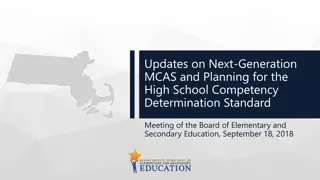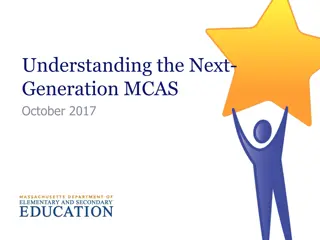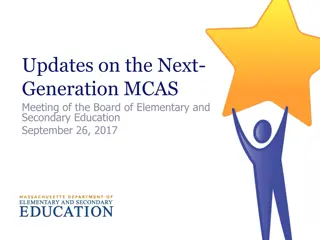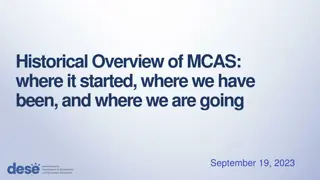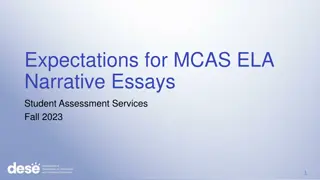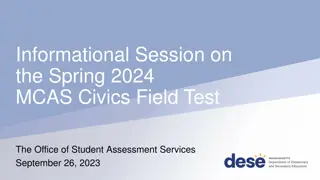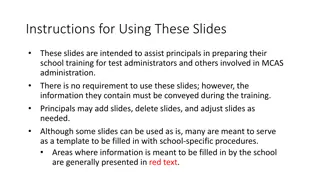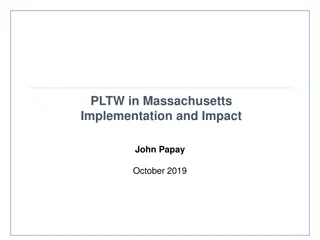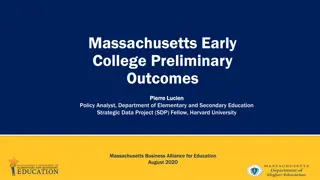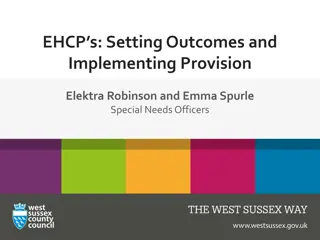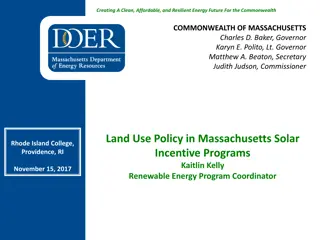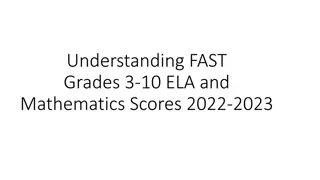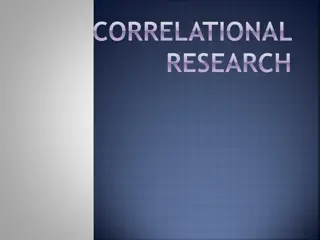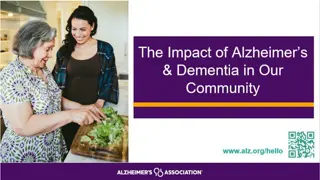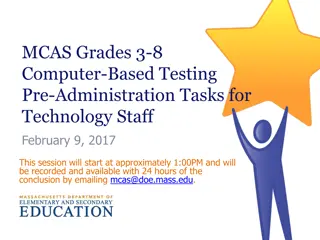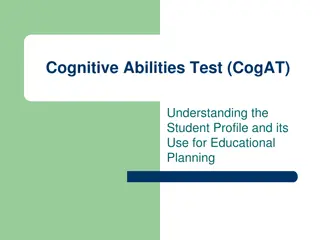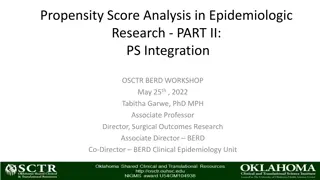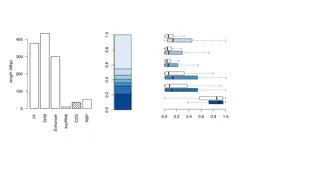Massachusetts Educational Policy Study: Long-Term Outcomes & MCAS Scores
This study from Brown University explores how high school MCAS scores in Massachusetts predict long-term success and academic skills, impacting students' college and career readiness. Findings indicate students near passing cutoffs struggle, but additional attempts can improve outcomes. MCAS scores correlate with higher future earnings in the labor market, with substantial variations.
Download Presentation

Please find below an Image/Link to download the presentation.
The content on the website is provided AS IS for your information and personal use only. It may not be sold, licensed, or shared on other websites without obtaining consent from the author. Download presentation by click this link. If you encounter any issues during the download, it is possible that the publisher has removed the file from their server.
E N D
Presentation Transcript
Competency Determination and Long-Run Outcomes in Massachusetts EDUCATIONAL OPPORTUNITY IN MASSACHUSETTS BROWN UNIVERSITY APRIL 2022 1 STRATEGIC GRANT PARTNERS
Study motivation and background How can evidence from nearly 2 decades of MCAS high-school assessments inform next steps for Massachusetts education policy? Our partnership addresses three broad questions relevant to discussions of the CD policy: How do MCAS scores relate to long-run outcomes? Are students scoring at different MCAS levels college-/career-ready? How do students affected by the policy fare? We use longitudinal data that tracks students through MA public schools to college and the workforce We focus on first-time 10thgrade test-takers. Long-run outcomes are for earlier test-taking cohorts (although we see quite similar patterns with more recent cohorts) We use 2019 earnings to avoid pandemic-related issues 2
Key takeaways (1) High school MCAS scores predict long-term success and appear to reflect students academic skills (not simply SES or school characteristics) (2) Students scoring near the passing cutoff do not fare well and do not appear to be college- or career-ready, on average (3) Most students who fail do retest and pass; barely passing does improve longer-term educational attainments (4) Students who earn their CD on retest or appeal have similar outcomes to students who barely passed their first try 3
High school MCAS scores predict long- term success and appear to reflect students academic skills (not simply SES or school characteristics) 4
MCAS scores reflect academic skills that pay off in the labor market We look at median annual earnings ~ age 30 for students at each MCAS score 75th Percentile Students with higher MCAS scores go on to earn substantially more in the labor market. 25th Percentile There is substantial variation in earnings at each MCAS score point (MCAS scores explain about 13% of the variation in earnings). NOTE: We only observe in-state earnings reported to the UI system. This excludes self-employed individuals or those who work for the federal government or military. Living Wage from MIT estimates for two working parents with two children. 5
MCAS scores predict earnings among similar students with the same education level and demographics Estimated average 2019 earnings by MCAS math percentile and educational attainment for demographically similar students who attended the same high school We compare students with similar demographics from the same high school. $90,000 4-year college graduates $80,000 $70,000 Among students with the same education level, students with higher MCAS scores have higher earnings. $60,000 2019 Earnings $50,000 Terminal high school graduates $40,000 $30,000 We also see large returns to educational attainments (particularly four-year college degrees) for students at the same MCAS score level. High school dropouts $20,000 $10,000 $0 25 2003-05 10th Grade MCAS Math Score Percentile 50 75 99 6
Comparing students with similar 8th grade scores, those with higher 10th grade have better longer-term outcomes We compare students with similar 8th grade MCAS scores and similar demographic characteristics who attend the same high school. Among these students, those who have higher 10th grade MCAS scores go on to earn more ~15 years later. $64,000 (+21%) 75th percentile Students scoring at the state average in 8th grade $53,000 State average 8th Grade MCAS 10th Grade MCAS Age 30 Earnings 7 7
Students scoring near the passing cutoff do not fare well and do not appear to be college- or career-ready, on average 8
We look at long-term outcomes for students scoring at four different parts of the test-score distribution Mathematics 8th %ile 39th %ile 8th %ile = Pass-Fail cutoff on legacy test in recent years 22nd %ile 22nd %ile = Needs Improvement/Proficient cutoff on legacy test 39th %ile = Partially meets/Meets cutoff on NextGen test NOTE: We only observe in-state earnings reported to the UI system. This excludes self-employed individuals or those who work for the federal government or military. Living Wage from MIT estimates for two working parents with two children. 9
Students near the Math passing cutoff are very unlikely to graduate from a four-year college Educational attainments for 2011 Math test-takers at select percentiles 8th P/F 22nd P/NI 39th M/PM State Avg HS Graduation 79% 89% 93% 91% Any College Enroll 45% 61% 74% 74% 4-yr College Enroll 11% 28% 48% 55% Any College Grad 12% 23% 40% 47% 4-yr College Grad 5% 17% 32% 42% NOTE: We measure HS graduation within 3 years of taking the 10th grade test, college attendance within 4 years, and college graduation within 7 years. 10
Most students who fail do retest and pass; barely passing does improve longer- term educational attainments 11
Raising graduation requirements can influence students in several ways Overall impact of increasing standards on schools, teachers, and students e.g., improved instruction, narrowing curriculum, increased motivation This is hard to study empirically without a good comparison group Impact on students directly affected by the policy because they fell on one side of the cutoff or the other. e.g., students scoring below 220 must re-test; those scoring 220-240 after 2010 must satisfy EPP Compare students with similar scores, on either side of these cutoffs, over time We are interested in two types of equity issues: Equity across groups: Did the policy have a disproportionate effect on students with special challenges stemming from poverty? Equity within groups: By specifying minimum score cutoffs, the policy inevitably treats differently students with essentially equal proficiency whose scores fall just on either side of the cutoff. Does this difference in requirements translate to differences in outcomes for students with similar skills? 12
Despite introduction of CD requirement, educational attainments have increased over time, particularly for low-income students We do not have similar data pre-2003 test- takers, but other sources do not show large drops when the CD policy was introduced. NOTE: the transition to ecodis complicates comparisons over time after 2014 NOTE: We measure HS graduation within 3 years of taking the 10th grade test, college attendance within 4 years, and college graduation within 7 years. 13
Many fewer students are failing the examinations on their first attempt NOTE: We measure failing the first test with scaled scores less than 220. 14
Most students who fail go on to retest (and pass) More than 90% of students who fail go on to retest at least once, most at the first retest opportunity. Those who fail their first retest tend to persist and continue to retest. Three-quarters of students who retest eventually pass. Few students appeal, but for those who do the success rate on appeals is about 75%. 15
Barely passing/failing the exam does affect student outcomes We compare students who barely pass the exam to those who barely fail. These students have similar academic skills, so any differences in outcomes are the impact of passing vs. failing. We focus on first-time 10th grade test-takers from 2003 to 2007. Barely failing the math exit exam affects student outcomes: Reduces the probability of graduating from high school for low-income students (by 3% points) but not higher-income students Reduces the probability of graduating from a 4-year college for higher- income students (by 2% points), but not low-income students. This could be a positive impact of passing (e.g., encouragement) or a negative impact of failing (e.g., discouragement). We find suggestive evidence of the former. 16
We use a regression-discontinuity design We zoom in near the cutoff and estimate what outcomes would have been for students who failed had they scored at the cutoff (but still failed). Estimated impact of passing (vs. failing) the exam Compare that to outcomes for students who scored at the cutoff and passed. 17
Barely passing the math exam increases the probability of HS graduation for low-income students at the cutoff For low-income students near the cutoff, just passing the MCAS math exam increases the probability of graduating from high school by three percentage points. No impact for higher-income students. 18
Barely passing the math exam increases the probability of graduating from a 4-year college for higher-income students For higher-income students near the cutoff, just passing the MCAS math exam increases the probability of graduating from a 4-year college by two percentage points (about 20%). No impact for lower-income students. 19
What to make of this evidence? First, we do not know whether these impacts reflect the encouragement of passing or the discouragement of failing. Suggestive evidence of encouragement based on students 8th grade scores, but not conclusive. Second, barely passing (vs. failing) the MCAS math exam appears to operate on different margins for these two groups. It is not a barrier to high-school graduation for higher-income students, but it does affect their college outcomes. Passing the MCAS math exam appears to affect the types of post- secondary institutions in which students enroll. 20
Students who earn their CD on retest or appeal have similar outcomes to students who barely passed their first try 21
Students who pass on retest or appeal graduate from high school at similar rates to students who pass with 220 We compare outcomes for students who (a) pass with a 220 on their first attempt; (b) pass on retest; or (c) satisfy the CD on appeal. Granted appeal Passed retest Scored 220 1st try Students who appeal are somewhat more likely to graduate from high school (as expected). 22
We see generally similar patterns for college attendance and college graduation. Students who pass on the first try have somewhat better four-year college graduation outcomes, but rates are quite low in general for this group of students scoring near the pass/fail cutoff. 23
Questions? john_papay@brown.edu 24
Appendix 25 STRATEGIC GRANT PARTNERS
Students who fail are disproportionately students of color, low-income students, and students with disabilities All 2018 Test-Takers Fail Math Fail ELA Fail Science White 63% 32% 22% 26% Black 9% 17% 14% 17% Hispanic 18% 46% 59% 51% Low-Income 30% 65% 70% 69% Student w/ disability 17% 51% 38% 43% English learner 7% 37% 64% 44% 26
Demographics of failing vs all test-takers, 2011 All 2011 Test-Takers Fail Math Fail ELA Fail Science White 71% 38% 33% 33% Black 9% 20% 19% 19% Hispanic 13% 36% 41% 41% Low-Income 31% 67% 73% 71% Student w/ disability 16% 56% 58% 45% English learner 4% 22% 38% 24% 27
Demographics of failing vs all test-takers, 2003 All 2003 Test-Takers Fail Math Fail ELA Fail Science White 78% 57% 46% N/A Black 8% 17% 20% N/A Hispanic 9% 21% 27% N/A Low-Income 21% 42% 53% N/A Student w/ disability 14% 37% 42% N/A English learner 5% 10% 22% N/A 28
Among students who retest or appeal, success rates are high 29
Students who fail ELA: MCAS performance NOTE: We measure failing the first test with performance level. 31
More than 90% of students who fail go on to retest at least once. Very few students appeal. Retests are quite common, while appeals are relatively rare. Retest at least once 76% of students who retest eventually pass. Most students who retest do so at the first testing opportunity. No retest or appeal Appeal at least once Students who fail their first retest persist. Success rate on appeals is about 78%. 32
(3) MCAS scores predict college performance above and beyond HS GPA, demographics, and school attended Probability of Earning Credit toward Graduation Relative to Students Scoring 220 We compare students with similar GPAs, demographics, high school, & college attended. +31% points Students scoring 260 are 31% points more likely to earn college credit towards graduation than similar students scoring 220. +14% points 33
Demographics of students failing have shifted English Language Learners account for an increasing proportion of the first-time test- takers who fail Math & ELA over time. In 2017-19, nearly 60% of students scoring below 220 on ELA were ELs. Most students who fail are now from low-income families and attend urban schools. Share of students failing ELA on first attempt Share of students failing math on first attempt 0.8 0.7 Proportion of those failing 0.6 0.5 0.4 0.3 0.2 0.1 0 ELL SPED Female Urban Low-Income ELL SPED Female Urban Low-Income NOTE: First-time test-takers who qualified for FRPL (pre-2014) or as economically disadvantaged (post-2014) in the test year are counted as low-income. 34
Most students who fail go on to retake (and pass on retest) NOTE: We measure failing the first test with performance level. 35
ELs who fail MCAS are equally likely to retest, but less likely to pass on retest Percent of students who fail MCAS who retest, pass on retest, and pass on appeal, 2016 Math ELA ELs Non-ELs ELs Non-ELs % Retest 91% 93% 85% 88% % Pass 1st Retest 28% 39% 37% 56% % Ever Pass 55% 72% 66% 75% % Pass on Appeal 11% 5% 3% 1% Retesting behavior is similar for ELs and non-ELs most students who fail retest. Non-ELs pass on retest at substantially higher rates than ELs. ELs are more likely to satisfy their CD on appeal than non-ELs. 36
Retest behavior and success is quite similar for students with and without disabilities Percent of SWDs & non-SWDs who retest, pass on retest, and pass on appeal, 2016 test-takers Math ELA SWDs Non-SWDs SWDs Non-SWDs % Retest 93% 90% 89% 85% % Pass 1st Retest 34% 38% 51% 41% % Ever Pass 68% 65% 74% 67% % Pass on Appeal 8% 6% 3% 2% Retesting behavior is similar for SWDs and non-SWDs most students who fail retest. Passing rates on retest are quite similar (if anything, higher for SWDs in ELA). SWDs are more likely to satisfy their CD on appeal than non-SWDs in math. 37


